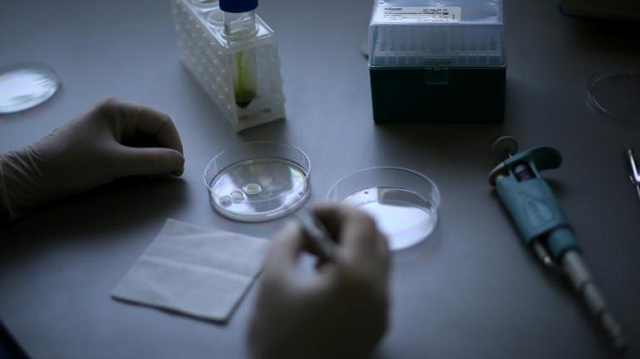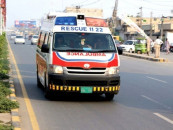Artificial skin -- a ray of hope for burn patients
Doctors and scientists have announced that they are ready to prepare artificial skin at a private lab

PHOTO: REUTERS
As a result, thousands of people continue to live with burnt marks on their bodies and some even lose their lives. However, there is finally a ray of hope for burn patients in Pakistan after local doctors and scientists have announced that they are ready to prepare biological or artificial skin on a large scale at a private laboratory.
To achieve this breakthrough, an agreement has been reached between the University of Health Sciences and the Pakistan Pharmaceutical Manufacturers Association (PPMA). Earlier imported for $900 (or Rs127, 440) per inch, artificial human skin will now be available at Rs1,000 and will be widely used to save the lives of people – even those with over 70% of their bodies burnt.
K-P gets well-equipped facility for burns victims
The biological replacement of human skin was first prepared in Pakistan at a local level in 2015, however, it was on an experimental basis. At present, scientists are in a position to produce artificial skin on a large scale.
Speaking about the matter, University of Health Science (UHS) Vice Chancellor Professor Javed Ikram said various infections, the release of water from the cells and rapid excretion of minerals from the body, among other conditions, can result in the death of most burnt patients.
“Mortality rate among patients with more than 70% of their bodies burnt is 90%,” Dr Ikram explained. “However, with the large-scale production of the biological human skin, surgeons will be able to reduce the burns to 20% and allow patients to live longer.”
Dr Ikram added that up until now, artificial skin was not being prepared in Pakistan because of which it had to be imported.
“Imported skin was naturally costlier and, consequently, out of the reach of most patients – especially those who hailed from moderate backgrounds”.
Recalling the tragic incident that took place in Ahmadpur Sharqia – where an oil tanker accident killed and burnt scores of people – Dr Ikram said that many people passed away because of the non-availability of human skin.
“Billions were spent to order artificial skin from abroad so that the lives of the injured could be saved,” shared Ikram. “However, more lives could have been saved we could produce artificial skin locally at the time.”
Dr Ikram further added that despite its low cost, the locally-prepared skin is of the same standards as those imported from Europe and the US.
“In fact, the skin which we have prepared in Pakistan is better than its imported counterpart in many aspects,” Ikram said. “We already have our skin specimen approved by the United States Food and Drug Administration (FDA) and we have also successfully used it on scores of patients.”
Explaining the procedure, he said that skin renewal comprises two parts: technical and regulatory.
“On the technical side, we have made 27 inventions including the skin which include pupil of the human eye, kidney cells and interferon injection which is given to Hepatitis patients,” Ikram said. “The work of a scientist is to invent things in the laboratory but the real issue is to use these inventions to the benefit of patients.”
Shedding light on the hurdles that his team has faced, Dr Ikram revealed that the greatest difficulty in terms of inventing artificial skin is related to regulation.
“We prepared the skin but there were several unresolved issues such as which institution would register the skin, which pharmaceutical company will be able to produce and sell the skin commercially,” Dr Ikram said.
Call for early treatment of burn injuries
“During the initial stages, we could not succeed due to the mafia that imported artificial skin and different medicines, but thanks to the Supreme Court of Pakistan which took Suo Motu notice on the matter and the former CJP constituted a committee to launch a probe within a designated time frame. Owing to that, our project became successful and patients can finally benefit from the technology.”
The artificial skin that has been produced by Dr Ikram’s team has been sent to DRAP (The Drug Regulatory Authority of Pakistan) for registration and the process is expected to be completed soon.
“An agreement has been reached with the representative body of the Pakistan Pharmaceutical Association (PPMA), through which around 20 large companies will manufacture the artificial skin and other medicines after which not only will these medicines be available at low prices in Pakistan but they can also be exported,” he said.
In preparing the skin, the most important role was played by Dr Rauf Ahmed who works for the Burns Unit at Lahore’s Jinnah hospital.
Speaking to The Express Tribune, Dr Rauf Ahmed – who holds a PhD in microbiology – detailed that artificial skin can be prepared using the surplus human skin that remains unused during surgery or even with skins of animals, like cows and buffalos.
In the first stage, the surface layer is removed from the skin with the help of chemicals. In medical terms, the process is called de-epidermalisation. In the second stage, the target area is subjected to de-cellularisation. The purpose of both these stages is to eliminate all types of viruses from the skin so that the new patch of skin will be accepted by a person’s immune system. In the following stage, the skin is sterilised so that it can be freed of germs. All these stages are cleared with the help of direct machines.
According to Dr Rauf, artificial skin can be kept for a year in solid shape and for around six months in storage. When using, it is made thinner with the help of different solutions. Once places, the skin becomes a part of the human body and a natural membrane is produced atop it, giving the body a homogenous colour.
Dr Rauf Ahmed further added that as compared to the US and Europe, the reason why Pakistani scientists have been successful in producing human skin at a cheaper cost is that that apart from original human and animal skin, there are chemicals and chemicals substances used during the preparation. These chemicals were obtained from those institutions that are either linked with their laboratories or through their sponsorship. The same chemicals used in the US and Europe are used in the preparation of skin here but they are less expensive in Pakistan.
“It takes eight days to prepare a single draft of artificial biological skin,” Dr Rauf Ahmed said. “We have a small laboratory and we can only prepare artificial skin on a small scale. We do not have the facility to produce it on a large scale in one small lab.”
A representative of the Pakistan Pharmaceutical Manufacturers Association, Haseeb Khan said that a Memorandum of Understanding (MoU) has been signed with the VC of the University of Health Sciences, adding that there is no institution or machinery in Pakistan that can manufacture these inventions on a large scale to save human lives.
“Now that we have reached an agreement with the UHS, large companies that operate under the PPMA have formed a joint consortium and we are bringing advanced machinery from Canada and Spain,” Haseeb Khan said.
“Artificial human skin, the pupil of the human eye, cells of kidneys and other biological medicines will be manufactured according to international standards,” he stated.
“Although we cannot give a date, the commercial production of these medicines and artificial body parts will begin soon and we will try to keep the prices at the lowest.”
Published in The Express Tribune, April 22nd, 2019.


















COMMENTS
Comments are moderated and generally will be posted if they are on-topic and not abusive.
For more information, please see our Comments FAQ